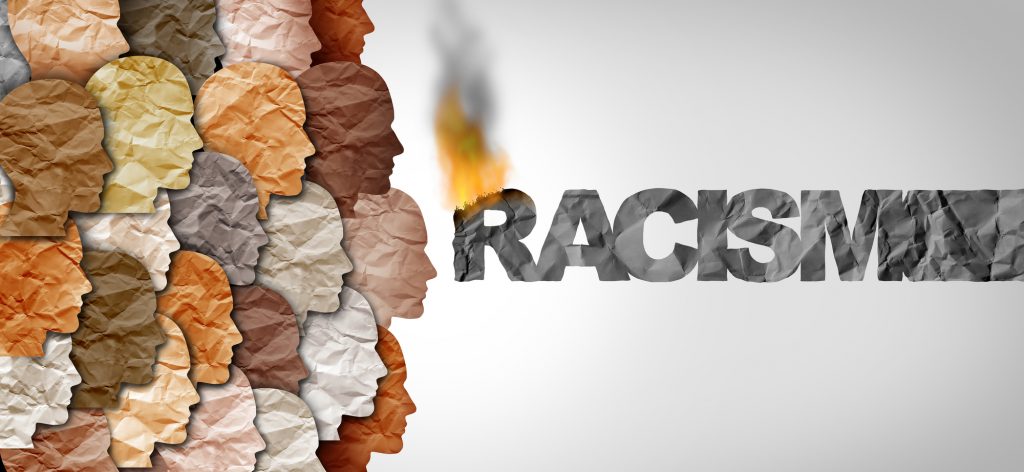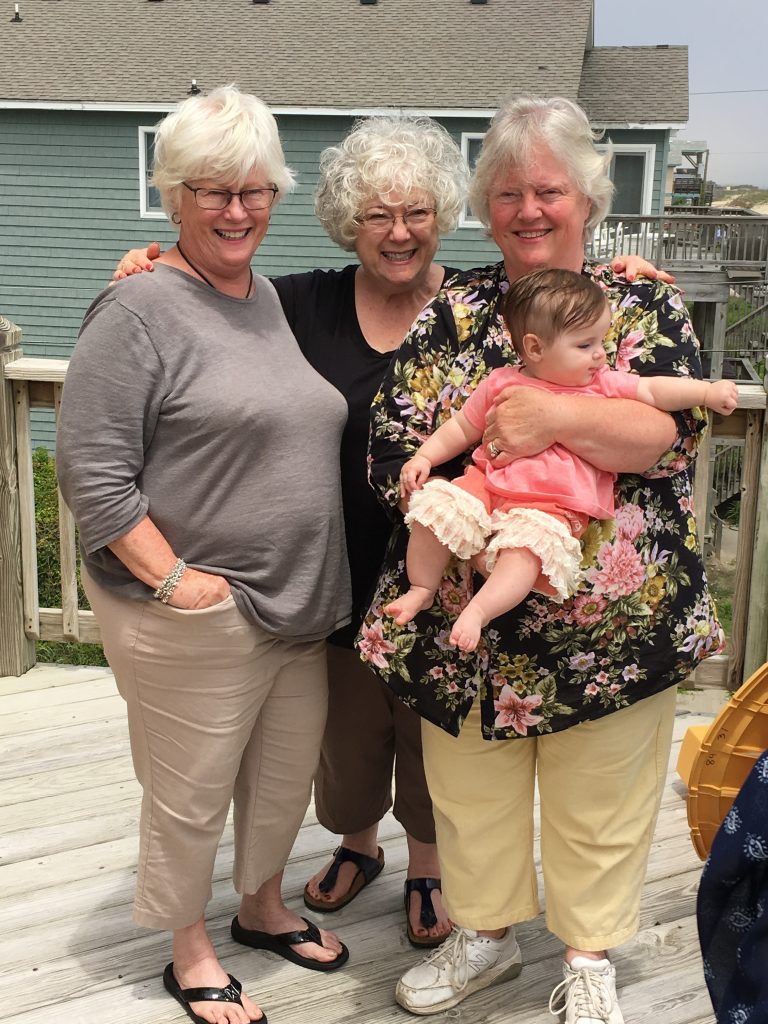
At 9 years old, I didn’t care that my mother wasn’t funny like Lucille Ball, or that she didn’t wear circle skirts and twirl around the house like Loretta Young, or that she was no longer pretty like Miss Kitty on Gunsmoke. I wanted my mother to be brave, like Annie Oakley. Not long after Rosa Parks sat on that bus in Montgomery, Alabama, in the whites-only section, I found out how brave my mother really was — and that Black Lives Matter.
Let me set the scene…
On the afternoon of Dec 1, 1955, Rosa Parks, a seamstress in a local department store, got on a public bus and took a seat in the section reserved for white people. Her actions, her arrest, and the bus boycott that followed became a landmark event in the Civil Rights Movement.
I was the oldest of three girls, living in the suburbs of Portsmouth, Virginia, with my parents and sisters, Laurie, age 6, and Eileen, age 3. My dad was in the Navy and my mother didn’t drive. When we needed groceries and my dad was at sea, one of the other Navy wives drove my mother to the commissary on the base. When we needed something from the “civilian” world, we walked to the end of our street and waited for the city bus that would take us downtown. It came by several times a day.
We didn’t go downtown often, maybe once every other month, if that. When we did, it was an event. Getting everyone dressed and fed in time for the morning bus brought its own challenges. My mother often sent me ahead to flag down the bus. Not because she dawdled. She simply couldn’t walk fast any more.
Three years earlier, while my mother was in the hospital giving birth to Eileen, something went wrong. I was too young to comprehend the details, other than she needed 3 big operations. Something about tying tubes, cutting an artery, and taking out a kidney that was as big as a football and solid rock. That all happened from late-May to the end of June. One day, the doctors said she wouldn’t live through the night. Obviously, she did. But she didn’t come home until Christmas Day, and that was only for a few hours.
Children under twelve weren’t allowed in the hospital, so other than Christmas Day, I didn’t see my mother for about eight months when she finally came home for good. By then, she was…different. She used to be the kind of pretty that made people turn their heads. Now, her hair, once long, thick shiny chestnut was dull and gray, the consistency of hay. Her skin looked pale like skim milk, watered down. It looked thin, as though a smile would tear it. She couldn’t walk without a heavy brace on one of her legs. She slept most of the time.
Over the next two years, she gained back a lot of strength. By 1956, she could walk without the brace. It hung on the coat rack in the stairwell leading up to my bedroom. I saw the steel and leather contraption at least twice a day.
Even before the three operations, my mother was different in other ways. Unlike some of the other mothers on our street, she didn’t eat potato chips, didn’t buy “trashy” magazines, and didn’t use the “n” word. She convinced my dad that we needed a complete encyclopedia, a set of the classics in literature, a regular dictionary, a medical dictionary, subscriptions to Life, Look, and National Geographic magazines, and Reader’s Digest condensed books. She made sure we watched the news with John Cameron Swazey and Walter Cronkite. My mother knew what was going in the world.
I guess because I was the oldest, she made sure I knew that the Supreme Court said segregation in schools was illegal. Not that anything in our town changed.
She made sure I knew when four colored churches in Montgomery, AL, had been bombed and when the homes of colored leaders, including Rev. Dr. Martin Luther King, Jr., were also bombed.
She told me a little bit about a 14-year old colored boy, Emmett Till, who was lynched and his body mutilated because some people said he whistled a white woman. She didn’t believe that’s what really happened but it upset her too much to talk about it. That was in 1955.
Now, on this particular day in 1956, the four of us got on the city bus and went downtown. Portsmouth had two five-and-dime stores, Woolworth’s and Grant’s. The front of each store was for white people, the rear for coloreds. Woolworth’s had two lunch counters, one in the front for whites and one in the back for coloreds. Separate water fountains and separate ladies’ rooms were all in the back.
That day, instead of sitting us at the lunch counter for white people, my mother took us to the rear of Woolworth’s and sat us at the lunch counter for coloreds.
A colored waitress asked my mother didn’t she want to go up front. My mother smiled and said no and proceeded to place our lunch orders.
Several white women came by on their way to the ladies’ room, the white’s only ladies room. One sneered. The other said something mean about my mother. I don’t remember the words. I do remember their anger. I wanted to yell at them but my mother shushed me and remained silent herself.
After we ate, my mother ushered us, like three little ducklings, toward the ladies’ room, the one for coloreds. That was when the waitress came over and quietly suggested we not go in there, that if we did, there could be real trouble — for us and for all the colored people who worked there. She and my mother shared what I can describe only as a “knowing” look. We used the white ladies room.
Later that afternoon, our shopping finished, we went outside and waited at the designated area on the sidewalk for our bus.
The bus arrived and, as was the procedure, we entered through the front door. The rear door was for exit only. My mother dropped the exact change into the glass hopper. She didn’t wait for the driver to confirm she had paid the right amount. She had counted it out multiple times while we were waiting on the sidewalk.
She scooted me and my sisters down the aisle. I was in the lead. I spotted four seats together and looked back at my mother for her approval. She shook her head and said, “Keep going.” We were awfully close to the signs that said “Coloreds.” Again, I turned to my mother. “Keep going.” There was a fire in her eyes that I hadn’t seen in a long, long time.
The bus was only half-full so when we all sat in the Coloreds section, I felt relieved to know we weren’t taking up all their seats.
We waited for the driver to start the bus. Instead, he turned around and glared at my mother. With words that might read polite on paper and a tone that was anything but, he told her that we needed to move up front. My equally polite mother said, “We’ll stay right here, thank you.”
The driver sat for another minute or two, muttering a string of swears we weren’t allowed to say in our house. Eventually, the bus took off. About thirty minutes later, I reached up and over my sister Laurie and pulled on the string to signal the driver that we wanted to get off at the next stop. There were still at least a dozen people on the bus, spread out in both sections.
Hovering over the rear door was a giant mirror, like a full moon shining down on the steps. The mirror was positioned so the driver could see people as they got off the bus.
We lined up at the door. As soon as it opened, I went down the stairs. My sister Laurie followed. My mother, who was carrying Eileen, handed her down to me. As soon as I had Eileen safely in my arms, my mother came down the stairs.
She had one foot on the ground when the door slammed shut and the driver took off. Fast! I screamed! People on the bus screamed…as the driver dragged my mother…a full block.
Laurie and I ran alongside the bus. I clutched Eileen to my chest. Clouds of dirt, gravel, and spiky sweetgum balls from last winter exploded like a scene from a war movie.
Finally, the driver opened the door. My mother tumbled to the ground like a rag doll.
There was no air conditioning on the bus so all the windows were open. As the bus pulled away, I remember the arms of colored people reaching through the windows, frantically waving, shouting prayers. White people might have been doing the same but I don’t remember seeing them.
I don’t remember how long we sat on the shoulder of the road, Laurie and I patting Momma’s bloody head, her bloody hands, her bloody knees, reciting the mantra we’d heard so many times. “You’re going to be okay…. You’re going to be okay…You’re going to be okay.”
Eventually, she was strong enough to stand and we headed home. I carried Eileen. Laurie held Momma’s hand and found her pocketbook on the side of the road.
Momma lived six more years. In that short time, she taught me many lessons. Some were about “bad boys.” I promised her I would never again kiss a boy who smoked and wore a leather jacket if I didn’t at least know his name.
Some lessons were about “good people,” like the woman in the fancy house a few blocks away who always let my mother pick pink camellias for our Easter outfits.
One lesson was about the toothless, shabby man who knocked on our door looking for work. Momma gave him a cleaning rag, a bottle of Windex, and three dollars to wash the outside of the living room window. He thanked her profusely and got right to work. When he left and was well out of sight, Momma went outside and washed the window all over again to get rid of the streaks. I got angry. Why would she give the shabby man what amounted to three weeks’ of my allowance for a job he messed up? She said it was a small price to help a man remember his dignity.
The biggest lesson came that day she got dragged by the bus driver. That was the day I learned about Black Lives Matter, though not in those words. The ones I heard my mother say over and over when she learned of an injustice were “That’s not right. That’s just not right.” That day on the bus, I saw my mother put herself in harm’s way to help make it right.
MAKE IT RIGHT
So, what can you do to help make it right? Here are a few ideas:
- Educate yourself. Watch documentaries about the struggle for Civil Rights. Here’s a link to a list of 10 must-watch documentaries suggested by PBS. http://www.pbs.org/black-culture/explore/10-black-history-documentaries-to-watch/
- Listen to the NPR podcast “On Being with Krista Tippett,” episode 847, an interview with Eula Biss – “Talking About Whiteness.”
- Call out racism when you hear it. Listen to yourself.
- Contact your state legislators and voice your opinion. Here’s a link .
- Support Black-owned businesses. An easy way to find them is with an Internet search. Simply Google “black-owned businesses in xxx” —your state.
- Donate to Civil Rights organizations, especially those with chapters in your area.
- VOTE! Election Day is Tuesday, November 3. Whether or not you can use a mail-in ballot depends on the laws of your state. Check with your town clerk. Don’t wait till the last minute!
RITUAL: “Colored”

In the meantime, here’s a ritual. I call it “Colored.”
I think of a ritual as a visible act performed with invisible intent. The invisible intent is to recognize the beauty of our connection to each other.
The visible act is to create a representation of your DNA, a gathering — by color — of your ancestors.
Science shows that we are all descended from the humans who originated in Africa. Reflect on that fact, then immerse your hands into a bowl filled with dozens of papers in different shades of blacks and whites, grays and creams, browns and pinks, reds and yellows.
If you have access to construction paper, you can cut strips of paper in varying shades. Or ask a paint store for discontinued paint chips. Since COVID-19 is still a serious threat, here’s an alternative that doesn’t require you to shop for construction paper or paints.
Gather paper and tear it into pieces about 2 x 2 inches. You can use a brown grocery store bag, a sheet from a yellow legal pad, scraps of paper from magazines, ordinary white copy paper. You can also stain some sheets with tea bags.
Pretend your job is to come up with names for the colors. Write one name on each scrap of paper, crumble the paper, then put it in a good-sized bowl, big enough for you to fit both hands.

Here are a few names to inspire your creativity. As you read them, imagine a color that would fit the name. Java / Chantilly Lace / Rootbeer Brown / Truffle / Pearl / Harvest / Acorn / Maple / Straw / Heron / Ink / Plaster / Parchment / Butter / Cream / Clay / Charcoal / Cinnamon / Kindling / Khaki / Flax / Pale Oak — You get the idea. As you imagine each color, look at your own skin. You might want to add Carob / Dunes / Wrought Iron / Linen. Don’t rush. There’s a lot of juice in this step.

Wrought Iron
Close your eyes, reach into the bowl, and pull out a fistfull of papers. Write down the names of the colors in your hand. They represent your ancestors, whether or not you ever knew them. Give yourself time to reflect. Look at your skin. Write down your thoughts.
 This ritual can offer valuable insights when done with a group. One by one, have each person take a fistfull of colors, take a photo of the names (to save time), and return the colors to the bowl before the next person chooses. That’s important!
This ritual can offer valuable insights when done with a group. One by one, have each person take a fistfull of colors, take a photo of the names (to save time), and return the colors to the bowl before the next person chooses. That’s important!
White Heron

Flax seeds
After everyone has chosen colors and has had time to reflect and write, have everyone share their colors out loud. Do you share a color with someone else? Imagining the color as your DNA, how does it feel to share your DNA with the other person? Shocked? Relieved? Excited? Curious? Proud? Ashamed? Guilty? Empowered?
A simple ritual like this can open the door to a conversation about race. And that’s an ongoing conversation we all need to have.
If you do this ritual, alone or with others, please let me know how it went. What was your reaction? The reaction of others? Will you do the ritual again with other people? Why? Why not? I’m not asking only because I’m curious. I’d really like to know how I can make this ritual better. Send an email to: zita@ritualrecipes.net.
If you know someone who grew up in the 50s and 60s like I did, if you’re having conversations with friends and family about racism — and I sure hope you are! — please share this article with them. Help make it right.


